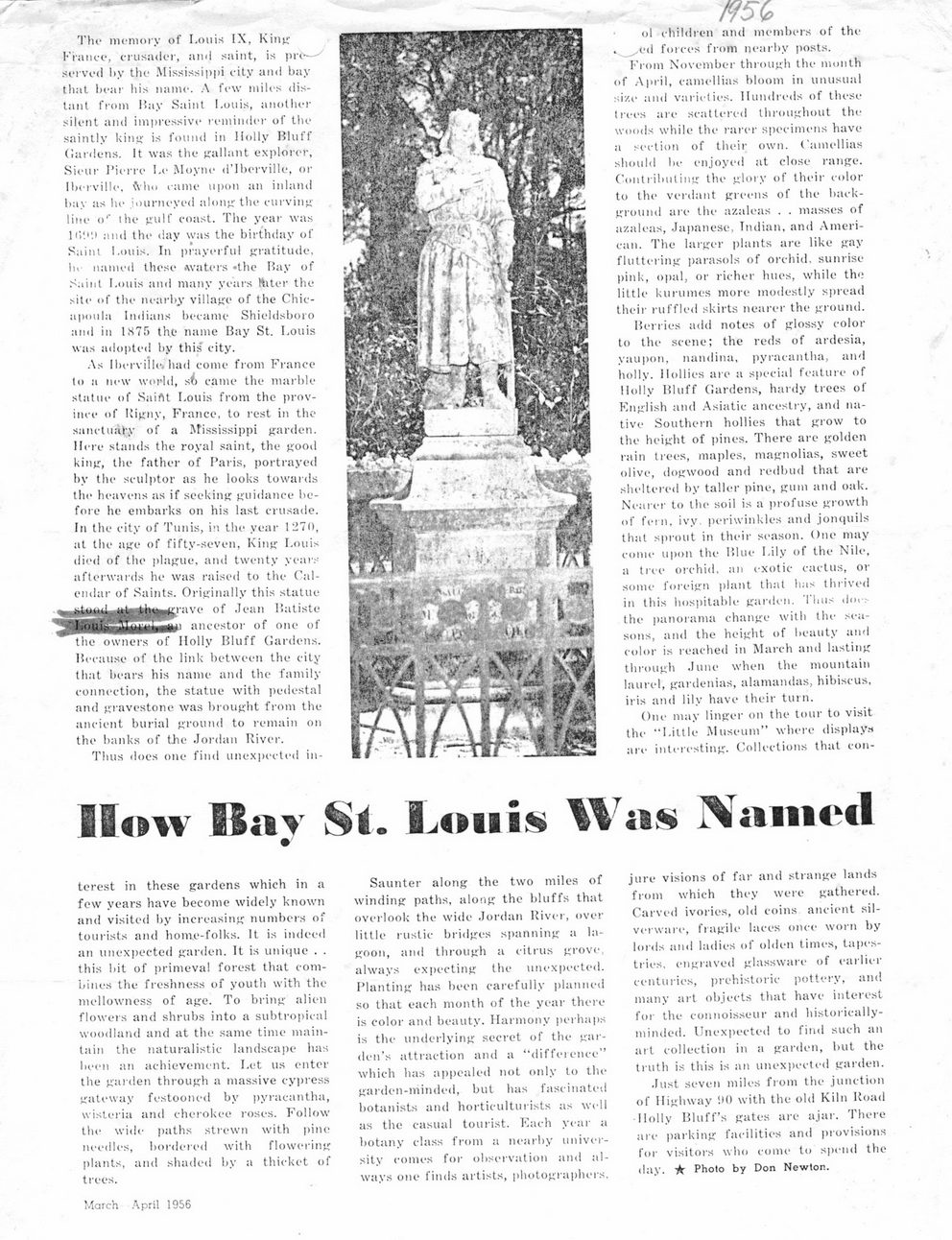This text was obtained via automated optical character recognition.
It has not been edited and may therefore contain several errors.
M5(e 'Dio memory of Louis IX, King Franco, crusader, ami saint, is pro-??/ served liy tho .Mississippi city and bay that boar lii.s namo. A few milos distant from Hay Saint Louis, another silent and impressive reminder of tho saintly kin.tr is found in Holly Bluff Gardens. It was tho trallant explorer, Siour Pierre Le .Moyne d'lborvillo, or Iberville, \Vho came upon an inland bay as he journeyed along tho curving lino o1' ihe gulf coast. Tho year was 11>'.1:> and the day was the birthday of Saint Louis. In prayerful gratitude. In named those Avaters ?tho Hay of Saint Louis and many years Hi tor the site of tho nearby village of the Chic-apoula Indians became Shieldsboro and in l.STT) the name Bay St. Louis was adoptoil by this' city. As Iberville, had come from Franco to a now world, sf> came tho marble statue of Saiflt Louis from the province of Rigny, Franco, to rest in the sanctualy of a Mississippi garden. Here stands tho royal saint, the good king, tho father of Paris, portrayed bv tho sculptor as ho looks towards the heavens as if seeking guidance before he embarks on his last crusade. In the city of Tunis, in tho year 1270, at tho age of fifty-seven, King Louis died of the plague, ami twenty years afterwards he was raised to the Calendar of Saints. Originally this statue stood at the grave of Jean Batiste Louis Morel, ancestor of one of the owners of Holly Bluff Cardens. Because of the link between the city that bears his name and the family connection, the statue with pedestal and gravestone was brought from the ancient burial ground to remain on tho banks of the Jordan River. Thus does one find unexpected in- ol children and members of tho .__,od forces from noarbv posts. From November through the month of April, camellias bloom in unusual si'/.o and varieties. Hundreds of those trees are scattered throughout the woods while the rarer specimens have a section of their own. Camellias should be enjoyed at close range. Contributing the glory of their color to the verdant greens of tho background are the azaleas . . masses of azaleas, Japanese, Indian, and American. Tho larger plants are like gay fluttering parasols of orchid, sunrise pink, opal, or richer hues, while the little kuruHies more modestly spread their ruffled skirts nearer tho ground. Beiries add notes of glossy color to the scene; the reds of ardesia, yaupon, nandina, pyracantha, and holly. Hollies are a special feature of Holly Bluff Gardens, hardy trees of English and Asiatic ancestry, and native Southern hollies that grow to the height of pines. There are golden rain trees, maples, magnolias, sweet olive, dogwood and redbud that are sheltered by taller pine, gum and oak. Nearer to tile soil is a profuse growth of fern, ivy. periwinkles and jonquils that sprout in their season. One may come upon the Blue Lily of the Nile, a tree orchid, an exotic cactus, or some foreign plant that has thrived in this hospitable garden. Thus dor-the panorama change with the seasons, and the height of beauty and color is reached in March and lasting through Juno when the mountain laurel, gardenias, alamandas, hibiscus, iris and lily have their turn. One may linger on the tour to visit the "Little .Museum" where displays are interesting. Collections that con- IStrw 1Sn> ! ? terest in these gardens which in a few years have become widely known and visited by increasing numbers of tourists and home-folks. It is indeed an unexpected garden. It is unique . . this bit of primeval forest that combines tho freshness of youth with tho mellowness of age. To bring alien flowers and shrubs into a subtropical woodland and at the same time maintain the naturalistic landscape has been an achievement. Let us enter the garden through a massive cypress gateway festooned by pyracantha, wisteria and ehorokoe roses. Follow the wide paths strewn with pine needles, bordered with flowering plants, and shaded by a thicket of trees. >4. Louis Saunter along the two miles of winding paths, along the bluffs that overlook the wide Jordan River, over little rustic bridges spanning a lagoon, and through a citrus grove always expecting the unexpected. Planting has boon carefully planned so that each month of the year there is color and beauty. Harmony perhaps is the underlying secret of the garden?s attraction and a ?diffeience? which has appealed not only to the garden-minded, but has fascinated botanists and horticulturists as well as the casual tourist. Each year a botany class from a nearby university comes for observation and always one finds artists, photographers. as Nantwl jure visions of far and strange lands from which they were gathered. Carved ivories, old coins ancient silverware, fragile laces once worn by lords ami ladies of olden times, tapestries, engraved glassware of earlier centuries, prehistoric pottery, and many art objects that have interest for the connoisseur and historically-liiinded. Unexpected to find such an art collection in a garden, but the truth is this is an unexpected garden. Just seven miles from the junction of Highway !M) with the old Kiln Road Holly Bluff?s gates are ajar. There are parking facilities and provisions for visitors who come to spend tho day. it Photo by Don Newton. March April 1956

Morel, Louis How-Bay-St.-Louis-was-Named